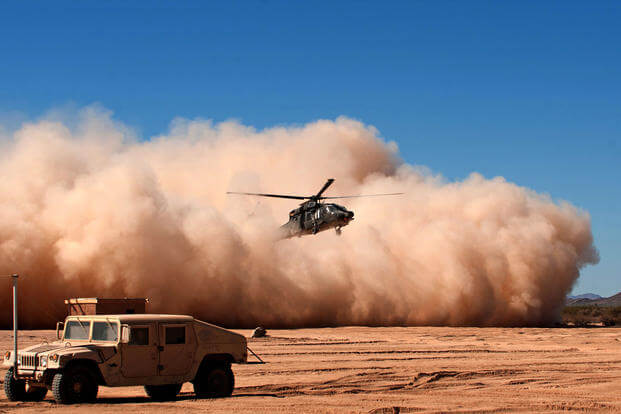Raytheon's Joint Precision Approach and Landing (JPAL) System has been used for years by the Navy to help guide fighter aircraft into clean tailhook landings aboard aircraft carriers. But now the company is pitching JPALs to the Army as a way to help rotorcraft operate safely in bad-weather conditions and land with confidence -- even in brownouts.
Navy Cmdr. Brooks Cleveland, a F/A-18 Hornet pilot and Raytheon's senior aviation adviser for precision landing systems, told Military.com at the Association of the United States Army annual meeting Monday that Raytheon was developing a smaller, rapidly deployable version of JPALS designed to be portable within a C-130 Hercules and fit within a Humvee on the ground.
JPALS uses a GPS satellite navigation system that links with aircraft from a distance to provide accurate guidance for landings. By relying on coordinates from the system, planes can avoid geographic obstacles and essentially "auto-land," despite any reduced visibility conditions.
Cleveland said Raytheon is now in conversations with the Army, as well as the Air Force, to discuss how the technology could improve aviation.
"This system, it takes the weather variable out of it so those high profile missions can happen," he said. "You just take one of the variables that might scrub it out. It opens up the aperture of what's possible."
A demonstrator for the deployable system is expected to be built sometime next year. The system is platform-agnostic, and can control up to 50 aircraft at a time within a radius of up to 20 nautical miles, Cleveland said.
Aircraft requirements to interact with the system are basic and configuration needs minimal: inertial navigation system and GPS, which come standard on most military aircraft, and a radio that can recognize the JPALs signals, a feature that can be configured with software.
In addition to opening the aperture for flight, Cleveland said increased safety could bypass potential crashes and other mishaps.
"With a precision landing system like this, you can get into that brownout condition, you just keep those needles centered, it will land you ... without having to worry about looking outside and getting disoriented, which is where a lot of these mishaps happen in the helicopter community," he said.
For now, the Army and Air Force have had discussions with Raytheon about JPALS, but have not taken any action to adopt the technology.
"What we're just trying to do is turn the light bulb on ... because of what it can do, the possibilities," Cleveland said.
-- Hope Hodge Seck can be reached at hope.seck@military.com. Follow her on Twitter at @HopeSeck.




























